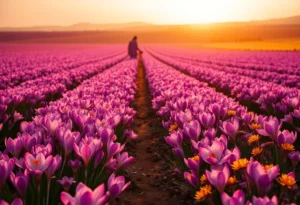The Value and Challenge of Authentic Saffron
Saffron has long held the title of the world’s most precious spice. Its deep color, complex aroma, and subtle yet powerful flavor have made it a prized ingredient for centuries. As saffron’s value has grown, so has the number of low-grade or adulterated imitations on the market. Recognizing genuine, high-quality saffron is essential—whether you use it in the kitchen, in tea, or for its cultural and traditional significance.
Visual Inspection: Thread Appearance
One of the most reliable ways to judge saffron quality is by examining the threads. The finest saffron features deep red stigmas, known as the “sargol” or “coupé” grade, which are hand-harvested from the crocus flower. These threads are typically unbroken and slightly trumpet-shaped at one end. Yellow or orange strands often indicate the presence of the style, included to increase weight but contributing little aroma or flavor.
Aroma: The Signature Scent
Aroma offers another key indicator. True saffron carries a warm, earthy, floral scent with subtle metallic and honey-like undertones. This distinctive fragrance comes from natural compounds such as safranal, crocin, and picrocrocin. An overwhelmingly sweet or perfumed scent may signal artificial scenting or alterations.
The Water Test
The water test is a practical method for checking authenticity. Place a few saffron threads in warm water or milk and let them steep for a few minutes. High-quality saffron will slowly release a golden-yellow color, not bright red or orange. The threads should not dissolve or lose their shape. If the color releases rapidly or the water turns reddish, artificial dyes may be present.
Taste: The Bitter Edge
Taste can reveal much about saffron’s authenticity. Pure saffron offers a slightly bitter, earthy flavor, never sugary or overly sweet. Sweetness may indicate sugar or additives used to mask inferior quality.
Origin, Handling, and Lab Testing
Saffron’s origin and handling play a significant role in its quality. The best saffron comes from regions with centuries of expertise and traditional harvesting methods. Quality depends not just on region but also on careful harvesting, drying, and storage. Properly handled saffron should undergo lab testing to confirm high levels of crocin (for color), safranal (for aroma), and low moisture content. At Zarafron, we partner exclusively with carefully vetted U.S.-based suppliers who uphold the highest standards for quality, testing, and ethical practices.
Packaging Matters
Packaging also impacts saffron’s quality. Because saffron is delicate and sensitive to light, heat, and humidity, it should be stored in airtight, opaque containers. Loose saffron sold in plastic bags, especially if stored in warm or well-lit environments, may have already lost much of its potency.
The Bottom Line
Distinguishing between high and low-quality saffron comes down to knowing what to look for: vibrant threads, genuine aroma, slow color release, a bitter edge, and thoughtful packaging. When handled with care and respected for its heritage, saffron is far more than a spice. It is a heritage ingredient that deserves attention and authenticity.




